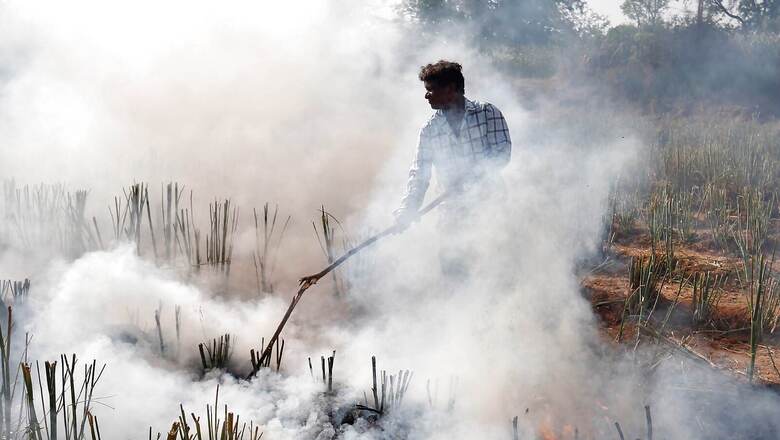
views
In the coming days, Delhi is most likely to witness intense pollution as stubble burning events could rise more in the neighbouring states such as Haryana, Punjab, and Uttar Pradesh, said environmentalists and weather experts. After a little relief from air pollution, the city’s air quality index deteriorated to the “poor” category on Wednesday as the fire count is 746 and its share in PM2.5 is 12 per cent, according to the Ministry of Earth Sciences’ forecast body SAFAR.
“Fire emission from upwind region enhances PM2.5 concentration as winds at transport level are from the northwest region. Stubble-burning share is likely to increase in the next two days if there is no rain. The overall AQI is likely to further degrade to the higher end of poor for next 3 days,” said the System of Air Quality and Weather Forecasting and Research (SAFAR) on Wednesday.
In the past few days, scattered rainfall over the national capital had significantly brought down the dust pollution level, keeping the city’s air quality index in the ‘good’ category at 82. Land surfaces are wet and therefore, dust re-suspension is minimum, leading to low PM 10 pollutant, said the SAFAR on Tuesday.
ALSO READ: No Rain, No Gain: Day After This Year’s Cleanest Air, Delhi’s AQI ‘Unhealthy’ Again
Speaking to Hindustan Times, Pawan Gupta, a research scientist at the Goddard Earth Sciences Technology and Research (GESTAR), Universities Space Research Association, said, “From Tuesday, we are seeing from satellite images that after the clouds cleared up, smoke is visible over north-west India. Get ready for more intense burning and smoky skies in the coming weeks.”
With tweeting satellite images of smoke enveloping northwest India due to stubble burning on Wednesday, IMD scientist Ashim Mitra said the air quality was under control for some days now due to rain, but after the rainfall stopped from Tuesday, the fire smoke started become visible again on satellite images.
The moment clouds disappear,smoke/#fire/#cropfire seen from #Sentinel2 over parts of #Punjab & neighbouring country, Oct/19. Fall in temperature & winds may bring pollutants from these #farmfires in neighboring states.@Pierre_Markuse @sentinel_hub #AirPollution #amritsar #Delhi pic.twitter.com/ZcjJxBg4sR— AshimMitra (@ashimmitra) October 20, 2021
The pollution levels during October to February due to various factors including stubble burning, road dust, vehicle pollution, and cold weather lead to deterioration in the AQI. Notably, Delhi has 36 monitoring stations that accurately record the levels of both particulate matters.
PM10 is particulate matter with a diameter of 10 micrometers and is inhalable into the lungs. These particles include dust, pollen, and mold spores. The presence of western disturbance has led to scattered rainfall over north India and low biomass burning, the System of Air Quality and Weather Forecasting and Research (SAFAR) said.
PM2.5 are finer particulate matter which can even enter the bloodstream. An AQI between 0 and 50 is considered “good”, 51 and 100 “satisfactory”, 101 and 200 “moderate”, 201 and 300 “poor”, 301 and 400 “very poor”, and 401 and 500 “severe”.
According to the data from the Indian Agricultural Research Institute (IARI), a total of 969 farm fires were recorded in the six regions with Punjab accounting for 788, Haryana for 155, one in Uttar Pradesh, four in Rajasthan, and 21 in Madhya Pradesh. No fire was recorded in Delhi. On October 19, 562 farm fires were recorded collectively in the six regions with Punjab accounting for 496, Haryana for 55, five each in Uttar Pradesh and Rajasthan, and one in Madhya Pradesh. No fire was recorded in Delhi.
EXPLAINED: Why Stubble Burning Continues To Have Delhi-NCR In A Chokehold
Earlier, 60 farm fires were recorded in the six states, of which Punjab recorded 57 incidents, Haryana one and Rajasthan two. There were no fires in Delhi, Uttar Pradesh, and Madhya Pradesh. However, the IARI said detection of burning events by satellites was hampered due to clouds over eastern Uttar Pradesh and Madhya Pradesh.
A total of 4,768 burning events were detected in the six states between September 1 and October 19, which are distributed as 2,942, 1,082, 625, zero, 34, and 85 in Punjab, Haryana, Uttar Pradesh, Delhi, Rajasthan and Madhya Pradesh respectively. Overall, the total number of burning events recorded in the six states is 56.7 per cent less than in 2020 to date. Punjab recorded a 65.4-per cent reduction, Haryana recorded a 6.9-per cent reduction, Uttar Pradesh recorded a 25.5-per cent increase, Delhi recorded a 100-per cent reduction, Rajasthan recorded an 88.8-per cent reduction and Madhya Pradesh recorded an 83.7-per cent reduction in the current season as compared to 2020.
Stubble burning in the neighbouring states significantly contributes to the air pollution in Delhi. The active fire events due to rice residue burning were monitored using satellite remote sensing, following the new “Standard Protocol for Estimation of Crop Residue Burning Fire Events using Satellite Data”. Punjab and Haryana attract attention during the paddy harvesting season in October and November.
Farmers set their fields on fire to quickly clear off the crop residue before cultivating wheat and potato. It is one of the main reasons for the alarming spike in pollution in Delhi-NCR.
(with inputs from PTI)
Read all the Latest News , Breaking News and IPL 2022 Live Updates here.




















Comments
0 comment